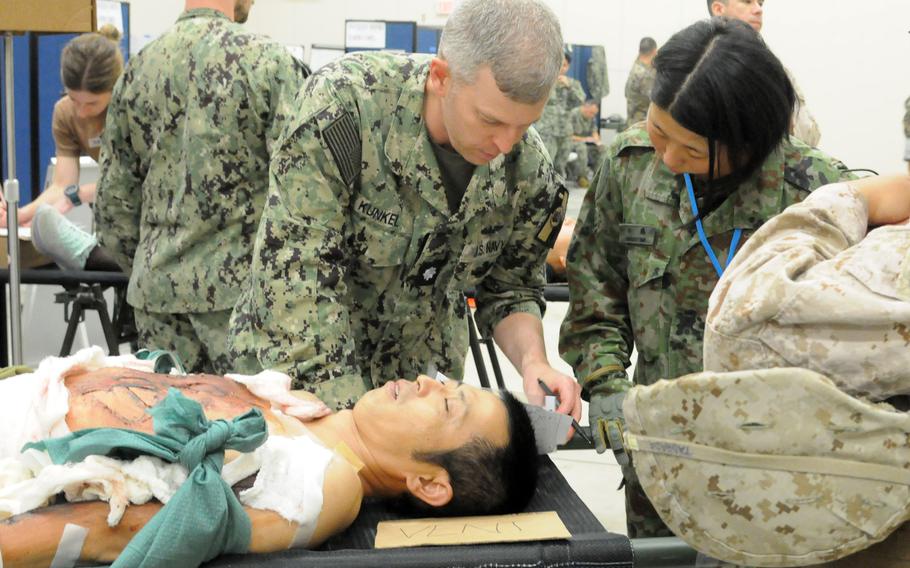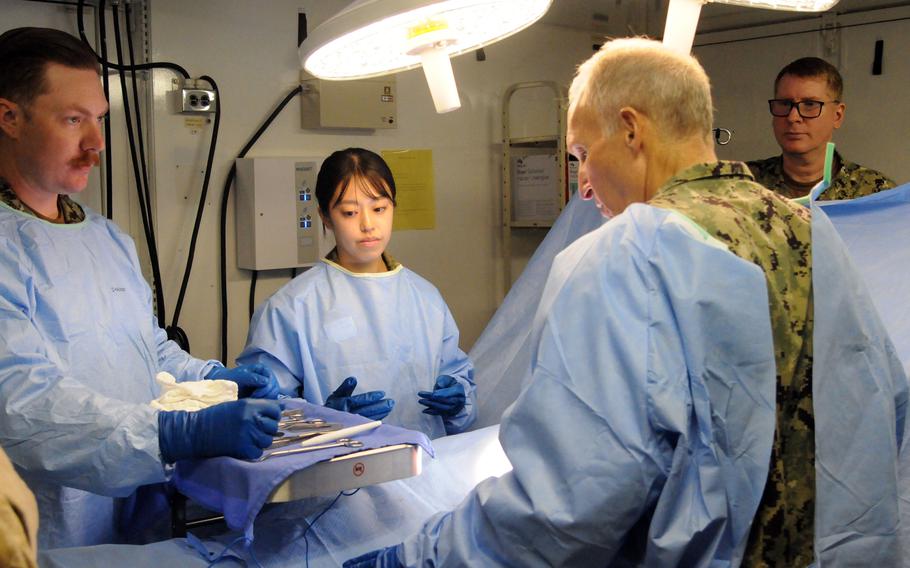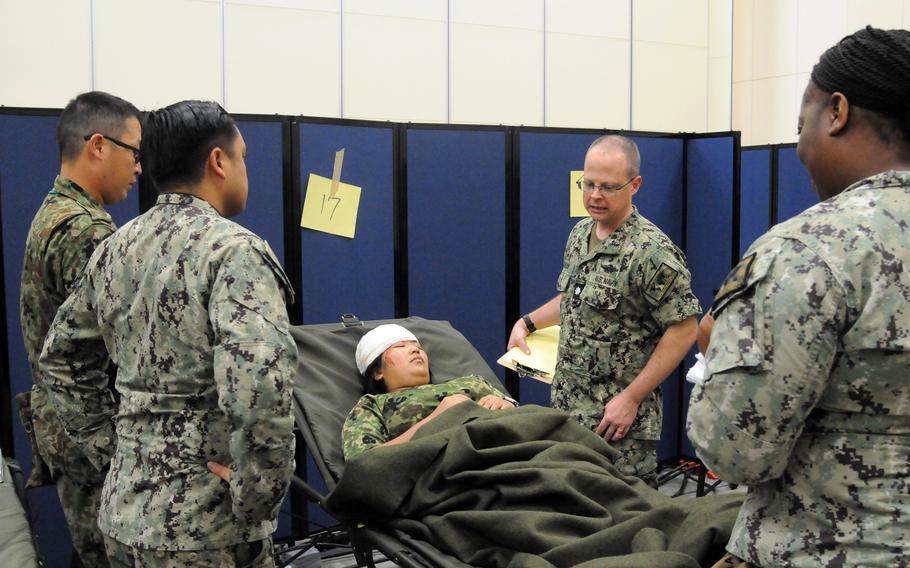
U.S. and Japanese service members confer over a simulated casualty during a Keen Sword drill at Camp Foster, Okinawa, Oct. 29, 2024. (Keishi Koja/Stars and Stripes)
CAMP FOSTER, Okinawa — Six U.S. Navy and Japanese doctors and nurses on Tuesday peered down at a bloody bone protruding from a patient’s left hip on an operating table in a warehouse at this Marine Corps base.
As gruesome as it seemed, the wound was only make-believe. As U.S. and Japanese troops trained on battlefield scenarios elsewhere across Japan, this surgical team was simulating an expeditionary medical facility as part of Keen Sword, a U.S.-Japan military exercise taking place throughout Japan until Friday.
Sixty-five Navy sailors took part in the drill, including doctors and nurses with the San Diego-based Expeditionary Medical Facility, along with sailors from Twentynine Palms, Calif.; Lemoore, Calif.; and Bremerton, Wash.; and reservists from across the United States.
The sailors, alongside Japan Ground Self-Defense Force counterparts, treated Marines and Japanese troops with simulated burn, blast and gunshot wounds from an imagined battle.
“[Japanese Self-Defense Force] and the U.S. EMF have integrated very well, almost seamlessly,” EMF Bravo’s commander, Capt. Ian Fowler, said at a news conference after a tour of the facility.

U.S. and Japanese service members confer over a simulated casualty during a Keen Sword drill at Camp Foster, Okinawa, Oct. 29, 2024. (Keishi Koja/Stars and Stripes)
The language barrier was a challenge left over from the 2022 Keen Sword drill, Fowler said.
“If you look at the medical records, they’re a hybrid of both Japanese and U.S. English in order to translate,” he said. “We also have implemented what we called ‘pointy-talkies,’ which are where service members can point to what they’re trying to say in one language to be able to translate that to another language.”
Patients arriving in ambulances from elsewhere on Camp Foster were triaged according to the severity of their mock injuries. From there, they went to the intensive care unit, an operating room or the acute care unit, Fowler said.
The expeditionary medical facility, located in a 77,550-square-foot warehouse, can accommodate 453 staff members, 20 intensive care unit beds, 130 acute care beds and four operating tables, Fowler said. For Tuesday’s drill, the facility had 10 ICU beds, 20 acute care beds and two operating tables.

U.S. and Japanese service members treat a simulated casualty during a Keen Sword drill at Camp Foster, Okinawa, Oct. 29, 2024. (Keishi Koja/Stars and Stripes)
The field hospital is a Role-3 facility, which can provide trauma surgery and other specialized surgery away from the battlefield or disaster area, Fowler said.
“Role-3 brings a lot of additional capacity and capability in terms of surgical specialties, so for instance we’ll have advanced trauma surgery and general surgery, but we’ll also have cardio-thoracic surgery, neurosurgery, urology,” he said
The facility can be operating at half-capacity within 72 hours after medical personnel arrive, and at full capacity after 10 days, Fowler said. While Camp Foster has all the equipment needed, the personnel come from U.S.-based expeditionary facilities — three on the East Coast and two on the West Coast.
Role-1 involves a corpsman or medic stabilizing the patient at the scene of the incident. The next step is a Role-2 facility, which was being drilled at the hospital in Naha, Fowler said.
“The goal of a Role-2 is to surgically stop the bleeding and get them here to our Role-3,” he said during the tour.

U.S. and Japanese service members discuss a simulated casualty during a Keen Sword drill at Camp Foster, Okinawa, Oct. 29, 2024. (Keishi Koja/Stars and Stripes)
Keen Sword is a biennial exercise that began in 1986 to increase combat readiness and improve the working relationship between U.S. and Japanese forces. This year’s training was expected to draw 12,000 U.S. and 33,000 Japanese troops, 40 vessels and 370 aircraft, according to a Joint Staff news release Sept. 26.
The Marine Corps’ Force Design plan includes expeditionary advanced base operations, which call for mobile units to disperse inside the range of enemy missiles to seize and hold islands and sink enemy vessels at sea. Expeditionary medical facilities go hand-in-hand with Force Design concept, Fowler said.
“I think training in the EMF Foster on a recurring basis allows our personnel to get their hands on equipment in the facility and be able to be ready for any contingency that arises here,” he said. “So, it’s very much expeditionary in nature.”
Stars and Stripes reporter Keishi Koja contributed to this report.